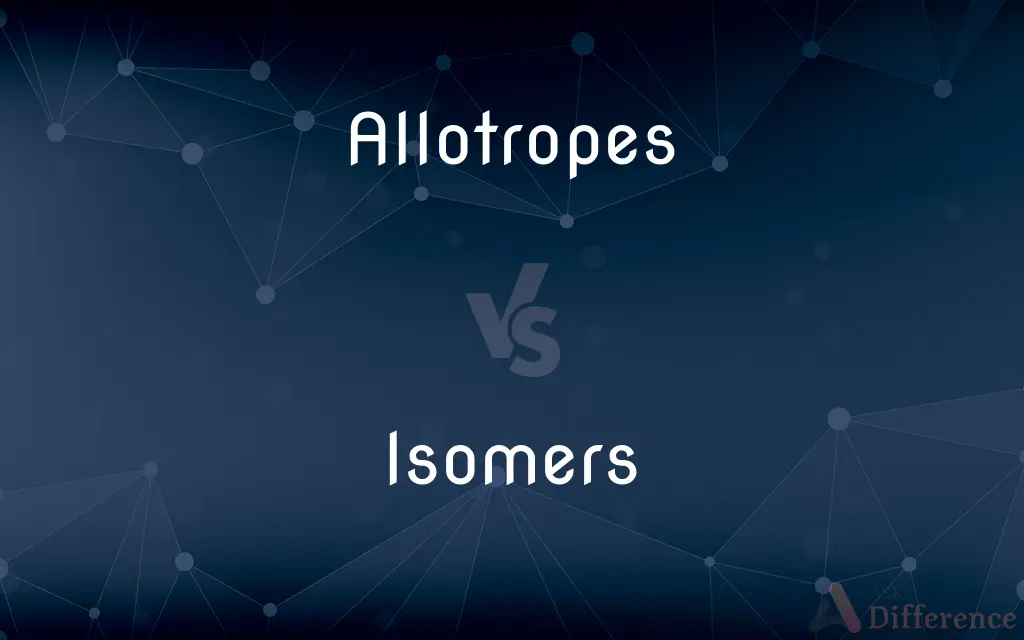Allotropes vs. Isomers — What's the Difference?
By Tayyaba Rehman — Published on January 7, 2024
Allotropes are different forms of the same element in the same physical state with different structures and properties. Isomers are molecules with the same molecular formula but different arrangements of atoms, resulting in different properties.

Difference Between Allotropes and Isomers
Table of Contents
ADVERTISEMENT
Key Differences
Allotropes are various structural forms of the same element, such as carbon existing as diamond, graphite, and graphene. These forms differ in their physical and chemical properties due to different arrangements of atoms. Isomers, in contrast, relate to compounds (not single elements) that have the same numbers and types of atoms but differ in their arrangement, leading to different chemical properties.
The concept of allotropy is limited to single elements. For instance, oxygen exists as both O2 and ozone (O3), each with distinct properties. Isomers, however, are specific to compounds, such as ethanol (C2H5OH) and dimethyl ether (C2H6O), which have the same molecular formula but different structures and properties.
Allotropes often exhibit markedly different physical properties, like hardness in diamond vs. softness in graphite, both forms of carbon. Isomers, while having the same atomic composition, can show significant variation in reactivity, boiling and melting points, and other chemical behaviors.
The formation of allotropes usually involves changes in bonding and structure under varying temperatures and pressures. Isomers result from different spatial arrangements of atoms within a molecule and can often be interconverted through chemical reactions.
Allotropes are a phenomenon observed in certain elements in the periodic table, notably carbon, oxygen, and sulfur. In contrast, isomerism is a broader concept in organic and inorganic chemistry, applicable to any compound with a particular molecular formula.
ADVERTISEMENT
Comparison Chart
Definition
Different forms of the same element
Molecules with the same formula, different arrangement
Example
Carbon as diamond, graphite
Ethanol and dimethyl ether (C2H6O)
Occurrence
In single elements
In compounds
Property Variation
Physical properties like hardness
Chemical properties like reactivity
Chemical Behavior
Result of different atomic structures
Due to spatial arrangement of atoms
Compare with Definitions
Allotropes
Same element, different structure.
Graphene is another allotrope of carbon with remarkable conductivity.
Isomers
Same molecular formula, different structure.
Butane and isobutane are isomers used as fuels.
Allotropes
Exhibit different physical properties.
The allotropes of oxygen include diatomic oxygen and ozone.
Isomers
Can have different chemical properties.
Isomers of C4H10 exhibit different boiling points.
Allotropes
Different structural forms of an element.
Diamond and graphite are allotropes of carbon with different hardness levels.
Isomers
Important in organic chemistry.
Structural isomers play a key role in pharmaceuticals.
Allotropes
Formed under different conditions.
Allotropes of sulfur are formed under various temperatures and pressures.
Isomers
Molecules with the same atoms but different arrangements.
Glucose and fructose are isomers with distinct sweetness levels.
Allotropes
Unique to certain elements.
Phosphorus exists in several allotropes, each with unique properties.
Isomers
Result of spatial arrangement.
The isomers of butene have different reactivity due to their double bond placement.
Allotropes
A structurally differentiated form of an element that exhibits allotropy.
Isomers
(Chemistry) Any of two or more substances that have the same molecular formula but differ in the way their atoms are connected to each other, in the spatial orientation of their atoms, or, in the case of large molecules such as DNA, in their molecular topology.
Allotropes
Plural of allotrope
Isomers
(Physics) Any of two or more nuclei with the same mass number and atomic number that have different radioactive properties and can exist in any of several energy states for a measurable period of time.
Isomers
Plural of isomer
Common Curiosities
Can you give an example of allotropes?
Carbon has several allotropes, including diamond, graphite, and graphene.
What are allotropes?
Allotropes are different forms of the same element, exhibiting different physical and chemical properties due to varying atomic arrangements.
Why do allotropes have different properties?
The difference arises from the varied ways atoms are bonded and arranged in each allotrope.
Do allotropes look the same?
No, allotropes of the same element can look very different, like the clear diamond and black graphite.
What is an example of isomers?
Glucose and fructose are isomers, sharing the same molecular formula C6H12O6 but differing in structure.
How are allotropes formed?
Allotropes form under different conditions like pressure and temperature, changing the atomic bonding in an element.
Can isomerism affect a substance's physical properties?
Yes, isomers can have different boiling points, melting points, and solubilities.
What are isomers?
Isomers are molecules with the same molecular formula but different arrangements of atoms, leading to different properties.
How do isomers occur?
Isomers occur when atoms in a molecule are connected in different ways, altering the molecule's shape and properties.
Are isomers just limited to structural differences?
Isomers primarily involve structural differences, but they can also include spatial (stereoisomers) differences.
Are allotropes found in all elements?
No, allotropy is specific to certain elements like carbon, oxygen, and sulfur.
What is the significance of allotropes in industry?
Different allotropes have unique applications, like graphite in lubricants and diamond in cutting tools.
Is isomerism common in organic compounds?
Yes, isomerism is quite common and important in organic chemistry, providing diversity in organic molecules.
Do isomers have different chemical reactions?
Yes, because their structural differences can lead to variations in chemical reactivity.
Why is studying allotropes and isomers important?
Understanding them is crucial in chemistry for insights into material properties, chemical reactivity, and molecular biology.
Share Your Discovery

Previous Comparison
Convenience Store vs. Grocery Store
Next Comparison
Exact Mass vs. Molecular WeightAuthor Spotlight
Written by
Tayyaba RehmanTayyaba Rehman is a distinguished writer, currently serving as a primary contributor to askdifference.com. As a researcher in semantics and etymology, Tayyaba's passion for the complexity of languages and their distinctions has found a perfect home on the platform. Tayyaba delves into the intricacies of language, distinguishing between commonly confused words and phrases, thereby providing clarity for readers worldwide.
















































